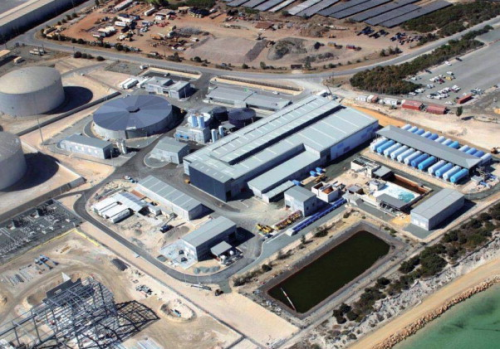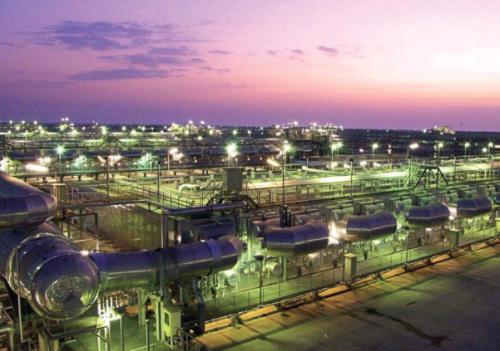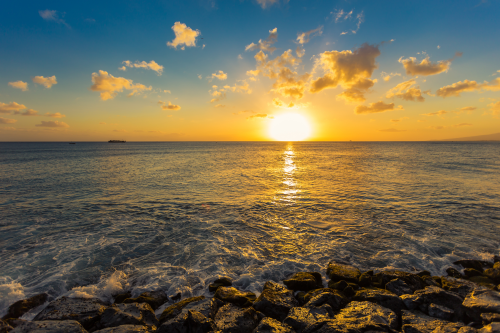


Today
According to the 25th Desal Data IDA Worldwide Desalting Plant Inventory, the installed capacity of desalination plants around the world as of June 30, 2012 was 74.8 million m3/d. This compares to 47.6 million m3/d in 2007, just five years previously, and only 1,000 m3/d in 1963. The cumulative contracted capacity, which includes plants that are contracted or under construction, reached 80.5 million m3/d, an increase of 4.1 million m3/d over the previous year. A total of 632 new plants were added from mid-2011 to August 2012, bringing to more than 16,000 the total number of desalination plants around the world. “While growth slowed somewhat during the first half of 2012 (the Inventory reports numbers as of mid-year), more desalination capacity than ever came online in 2011,” Awerbuch explained. There was an 18% increase in total online capacity between the 24th and 25th Inventories. “This added more than ten percent to the total online capacity for the fifth consecutive year,” Awerbuch added. “As noted earlier,” Awerbuch commented, “desalination has become a well established and increasingly critical part of water resource management strategies around the world, with its unique ability to provide a new and sustainable source of fresh water. We need only to compare the global online capacity over the past decade to understand its importance.” In 2002, the total cumulative online capacity was 31.8 million m3/d, less than half the current online capacity. Going further back to 1992, online capacity was just 16.5 million m3/d, meaning that desalination has seen a massive increase of more than 58 million m3/d in the past 20 years. “The continued growth in the market for desalination is due to a number of factors including population and economic growth, pollution or degradation of existing water resources, and the impact of climate change,” Awerbuch explained. Around 60% of global desalination capacity treats seawater; the remainder treats brackish water (21%) and less saline water. Six percent of the total worldwide desalination capacity is used to treat wastewater. Municipal users account for nearly two-thirds of the market (installed capacity), while industrial users represent 26%, followed by power stations (6%), irrigation and tourism (2% each), military (1%) and demonstration plants plus other applications, also at 1%. In terms of desalination technology, the highest proportion representing 63% of total worldwide installed capacity uses RO (see Figure 4). This is followed by the two major thermal processes, MSF at 23% and MED at 8% (see Figure 5). ED accounts for 3%. Hybrid technologies that combine thermal and membrane processes represent 1% of the total installed capacity. “Recently there are signs of an upturn in thermal desalination technology,” Hill commented, “as new and more efficient MED processes have been developed but this is relatively small compared to continuing RO growth.” “With the installation of Ras Al Khair in the Kingdom of Saudi Arabia,” Awerbuch added, “and with projects like Fujairah One and Two in the UAE, hybrid technology is rapidly being adopted in new and expansion projects.” The IDA expects the share of hybrid technology to grow to in excess of 3.5 %. As already mentioned, large scale desalination has mainly been built in the Gulf region where there is no alternative for public water supply. “The combination of lower cost membrane desalination and increased water scarcity,” Awerbuch explains, “means that big desalination plants are now being built outside the Gulf.” The largest membrane desalination plant in the world, the 444,000 m3/d Victoria Desalination Plant in Melbourne Australia, came on line in 2012, but it will be soon surpassed by the 500,000 m3/d Magtaa plant in Algeria, and the 510,000 m3/d Soreq plant in Israel. The largest thermal desalination plant in the world is the 880,000 m3/d Shoaiba 3 desalination plant in Saudi Arabia, although this will be displaced in 2014 as the largest desalination plant in the world by the 1,036,000 m3/d Ras Al Khair project in Saudi Arabia, which uses both membrane technology (RO at 308,000 m3/d) and thermal technology (MSF with a capacity of 728,000 m3/d). The eight thermal MSF units, each with a capacity of 91,000 m3/d, represent the world’s largest single train in desalination. While the Gulf countries produce between 40-50% of the world’s desalinated water, desalination is practiced in 150 countries, from Australia to China and Japan, the United States, Spain and other European countries, the Middle East and North Africa. “Latin America is emerging in importance as a desalination market,” Awerbuch explains, “particularly due to mining projects in Peru and Chile. In addition, Asia is an increasing force in the market.” Awerbuch added: “China is now one of the most important emerging markets for desalination.” The 12th Chinese Five-Year Plan establishes a goal of having 2.2-2.6 million m3/d of online desalination capacity in place by 2015, more than double the capacity added in 2012 when the plan was initiated. “That is one of the reasons that the IDA will hold its 2013 World Congress there,” Awerbuch added. The conference will be held in Tianjin, China, 20-25 October 2013.
The future
“One of the most significant trends in desalination is the ongoing quest to further lower energy requirements,” Awerbuch explained. “While the desalination industry has achieved a more than fifty percent reduction in energy consumption over the past two decades, work continues to lower energy consumption even further.” In 2012, the IDA organised a global Energy Force that challenged the industry to reduce by 20% the energy consumption of all major seawater desalination processes by 2015. This Task Force convened its first meeting this January in conjunction with the International Water Summit in Abu Dhabi. The purpose of that meeting was to create a framework for the establishment of guidelines to meet the energy reduction objective. “Much progress was made during that session,” Awerbuch explained, “and delegates established preliminary agreement on the theoretical minimum energy requirements of desalination, proposed a commitment and partnership with different representative groups (such as construction companies; desalination equipment suppliers; governments, local authorities and public utilities boards; and private users, academia and research centres), and also established a timeline for development of its guidelines for reducing energy consumption.” By August 2013, the Task Force will confirm and justify its targets. During the second half of 2014, the IDA will organise a follow-up conference on Energy in Desalination that will also include participation by its Environmental Task Force. The Task Force will present its recommended guidelines to achieve the 20% energy reduction goal at the 2015 IDA World Congress. “In terms of specific steps to further reduce energy requirements,” Awerbuch added, “the industry is already pursuing several interesting directions. One is the development of new technologies that have the potential not only to decrease the energy footprint of desalination technology, but also to decrease the cost of water at large. Another direction is to retrofit existing plants.” Studies indicate that almost 200 MW could be saved in the Middle East alone through simple value-engineering retrofits. “Technological advancements,” Awerbuch explained, “are being made in both thermal and membrane processes.” On the thermal side, developments include increasing MED efficiency from 10 to 15 tons of distillate per ton of steam extracted at low pressure from power plants. Reducing electrical power to run the MED process to 1.0-1.8 kWh/m3 levels is below the electrical energy requirements of RO. “But to be sure,” Awerbuch added, “RO is still the most efficient desalination process today.” The unit size of MED has already reached 68,000 m3/d, however, rapidly catching up with MSF at 91,000 m3/d at Ras Al Khair . New ideas for thermal desalination include low energy application of MED and MSF technology, low temperature distillation and membrane distillation. “Each of these has been proven in either a pilot plant or medium-size industrial plant,” said Awerbuch. “Looking at membrane technologies,” Awerbuch added, “developments include work in forward osmosis, which has already been proven in a small industrial plant and is now being contracted for larger applications. High efficiency RO, which can substantially increase recovery rates, is also being employed. “Biomimetic membranes, pressure retarded osmosis and carbon nanotubes are also in the development or demonstration phases. And of course, nanoporous and graphene membranes offer the promise of a drastically more efficient membrane process.” “Use of solar and renewable energy is going to play a significant role for both thermal and membrane processes,” Awerbuch added. MASDAR, in Abu Dhabi, has launched an initiative to build the world’s first large scale, commercially viable desalination plant powered completely with renewable energy by 2020. “This is not the industry’s first foray into using renewable energy to power desalination, “Awerbuch explained. “The plant in Kwinana, Australia, for example, offsets entirely its electricity requirements with wind power. Moreover, Saudi Arabia is also heavily investing in exploration of solar power for desalination.” A 136,000 m3/d RO desalination plant using photovoltaic cells is being constructed. “One of the challenges for our industry is taking these technologies from the laboratory or pilot phase into commercialisation. That is one of the significant aspects of the MASDAR project,” Awerbuch added. “The revolution in energy, brought about by enhanced oil recovery and horizontal hydraulic fracking, calls for new solutions in solving water recovery, water reuse and zero liquid discharge from flowback and produced water. Similar concerns with global climate and environmental considerations are bringing a focus on water, the essence of life, to the forefront of global interest in desalination and advanced water reuse,” Awerbuch concluded. “In the future,” Birkett added, “desalination will be recognised as a common resource option rather than a novelty; this is already true in much of the world beyond the US. More utilities and municipalities will follow the lead of Singapore and think in terms of their overall portfolio of water resources and the concept of drought proofing. “Water reuse, often employing technologies originally developed for desalination, will become common, having overcome initial public resistance. Economies of scale will continue to favour municipal plants over smaller decentralized units for seawater conversion although smaller water reuse systems will grow, following the Australian concept of sewer mining.” “A word on emerging technologies though, “Birkett concluded. “Remember that the terms membrane, nanotechnology, graphene, etc., refer to materials and not to processes such as RO, ED, MSF. Certainly these materials may enhance existing processes but they will not necessarily replace them. Wholly new processes may be required and I don’t know just what they will be. “Which brings us to thinking outside the box … remember, there is always a box. It may be bigger than everyone thinks but it is there somewhere. It may be called the second law of thermodynamics or the law of conservation of mass or of energy or something else, but Nature has set limits on what we can do. There is a minimum energy of separation which we cannot fly below, however much we want to and however much we have selfishly wasted or degraded our natural resources.”
Further information
Caird & Rayner Energy Recovery Inc. International Desalination Association Membrane Technology Associates Ltd. West Neck Strategies Inc. Whitewater Ltd. Return to Part 1 of Desalination : 50 years of progress





